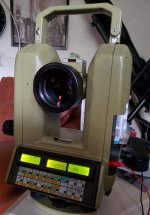Ethan Scott
Plastic
- Joined
- Sep 8, 2020
Thanks for the detailed information.
Follow along with the video below to see how to install our site as a web app on your home screen.
Note: This feature may not be available in some browsers.
I'll second that again too. I have definitely gained a bit more insight into the instruments, so thanks to all who replied.
I managed to pick up another interesting instrument a little while ago for pretty much no money. A theodolite - or more accurately a total station. It is a Swiss-made Wild Heerbrugg T3000 surplused from Lockheed Martin. Been having some fun playing with that. This particular instrument reads to 0.1 arc-second - standard deviation is claimed to be 0.5 arc-second. Just playing around with it I placed it at a set distance from my television and measured pixel pitch. Looked up the spec online and my TV has a pixel pitch of 58.7 pixels per inch, or almost exactly 0.017" pixel pitch. I took several angular measurements from the center of a red pixel to the center of the next red pixel and averaged. After calculating, damned if that thing didn't nail it right on the dot. Farthest from average was something like 0.0002" or thereabouts. Pretty neat.
Got the idea to get one to play with from a guy on YouTube that checked the accuracy of his dividing head with one. Figured I couldn't go wrong even just using it as a telescope for the kids for the price. The optics are very sharp and about 60x at infinity focus.



resolving power think 1/100" ruler or scale. you reach a point where markings so thin hard to see or read.
.
some optical instruments have a 10 arc second crosshair. how I know 1 arc second is .006" wide at 100feet so 10 arc second is .006" wide at 10 feet. just looking at a 1/100" ruler at 10 feet you can measure width of crosshair
.
focused at infinity you dont talk about .001" only arc seconds

Yes, was thinking about picking one up if I get a chance at one cheap for playing around with, possibly surface plate checking. And those kinds of links are exactly what I was looking for, thank you cameraman.
I would suggest a cheap ( < $500 ) Davidson Optronix dual axis. Send it to Davidson for a service, might need cleaning and gluing back the splitter - their most common issue. It is an excellent product , can focus very close and has a large aperture - can use small targets in low light. You can make your own mirrors and right angles.
Sorry if this was already discussed - haven't read the whole thread.
Happy to see it. Wasn't aware of that problem.
I have three of the Davidson D-600's holding down storage racks. Round Tuits to fab new light sources are on backorder, as usual.
I did get one wedge and two of the - WTH are they? Parallel differential? mirrors as well.
 but I think yours in full kit could split 0.2 microns in a meter. Needless to say, you breathe reading is gone.
but I think yours in full kit could split 0.2 microns in a meter. Needless to say, you breathe reading is gone. 
I don't know the 600 - I think that's a kind of comparator and way to accurate for my needs. I have the large aperture one, the 656. I ( used to ) need the low light capability. Usually splitters are comming apart and and ( I suppose ) there may be some fungus problem. All fixable. Under serious correctionbut I think yours in full kit could split 0.2 microns in a meter. Needless to say, you breathe reading is gone.


Just to think about that number in resolving power is wow..... The finest it can resolve is .00001 degree, when set in decimal degrees mode. .
Just to think about that number in resolving power is wow.
Bob

Just to think about that number in resolving power is wow.
Unless I mucked up this is a 5 inch target fifty miles away for your tank gun or laser gun ignoring all the other things.
This here old school stuff. No lasers, no high tech just plain optics.
Bob
Even more wow, by my calculation that's 0.553" at 50 miles.
That's what I typed in first and then I thought that impossible so recalculated and oops.Even more wow, by my calculation that's 0.553" at 50 miles.
Only in a vacuum. Main reason Hubble & c. can do so much better than ground-based giants many times their size.
Even an ordinary K&E transit, we had distortion off thermals and turbulence in the atmosphere at but a hundred yards or several - depending on weather, humidity, and time of day.
Notice
This website or its third-party tools process personal data (e.g. browsing data or IP addresses) and use cookies or other identifiers, which are necessary for its functioning and required to achieve the purposes illustrated in the cookie policy. To learn more, please refer to the cookie policy. In case of sale of your personal information, you may opt out by sending us an email via our Contact Us page. To find out more about the categories of personal information collected and the purposes for which such information will be used, please refer to our privacy policy. You accept the use of cookies or other identifiers by closing or dismissing this notice, by scrolling this page, by clicking a link or button or by continuing to browse otherwise.
